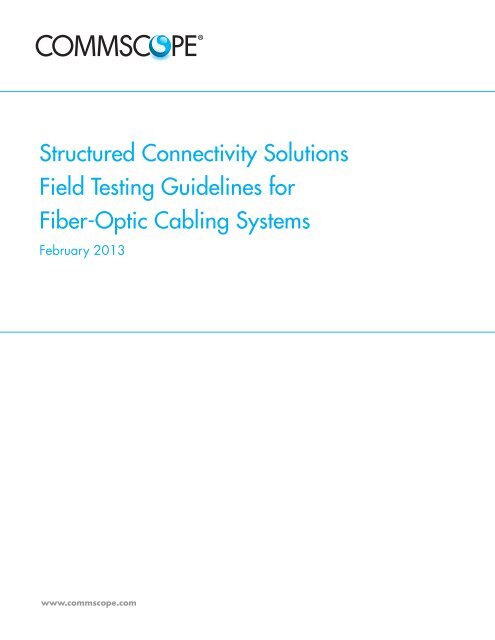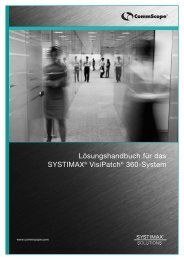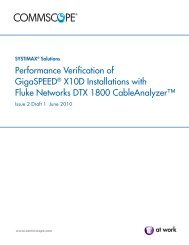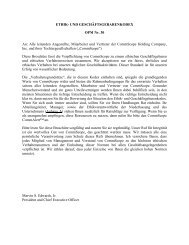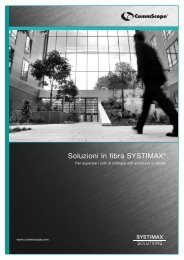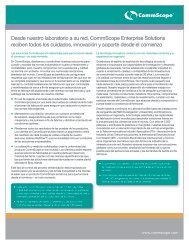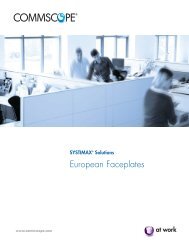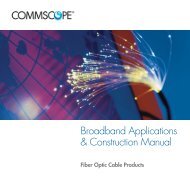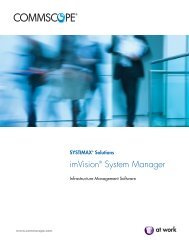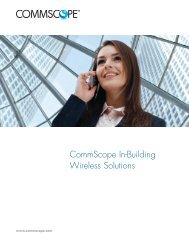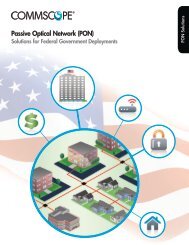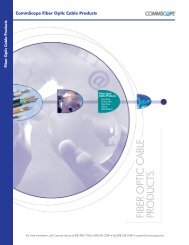II-106524EN_Field Testing Fiber Optic2.indd - CommScope
II-106524EN_Field Testing Fiber Optic2.indd - CommScope
II-106524EN_Field Testing Fiber Optic2.indd - CommScope
Create successful ePaper yourself
Turn your PDF publications into a flip-book with our unique Google optimized e-Paper software.
Structured Connectivity Solutions<br />
<strong>Field</strong> <strong>Testing</strong> Guidelines for<br />
<strong>Fiber</strong>-Optic Cabling Systems<br />
February 2013<br />
www.commscope.com
Contents<br />
1. Introduction 3<br />
2. Passive Link Segments 4<br />
3. General <strong>Testing</strong> Guidelines 5<br />
4. Acceptable Attenuation Values 7<br />
5. <strong>Testing</strong> Procedure for Single <strong>Fiber</strong> Connector Solutions 8<br />
5.1 Overview 8<br />
5.2 Relative Power Measurements 8<br />
5.3 Test Cord Performance Verification 9<br />
5.4 Link Segment <strong>Testing</strong> 11<br />
5.4.1 Case 1: Matching Connector Types between Test Equipment and Cabling 11<br />
5.4.2 Case 2: Differing Connector Types Between Test Equipment and Cabling 12<br />
5.5 TIA and ISO/IEC Standards 14<br />
6. <strong>Testing</strong> Procedure for Solutions Utilizing MPO Connectivity 15<br />
6.1 Overview 15<br />
6.2 MPO Case 1: Link with an MPO Trunk Connected to MPO to LC<br />
(or SC, ST) Modules on Each End 15<br />
6.3 MPO Case 2: MPO Trunk Cable <strong>Testing</strong> – For 40/100G Applications<br />
or When MPO-LC Fan-out Cord Will be Connected at a Later Date 17<br />
7. Troubleshooting 18<br />
7.1 Cable Plant Defect Detection and Resolution 18<br />
7.2 Test Equipment Checklist 19<br />
Appendix A: Encircled Flux Launch Conditions 20<br />
Test Instrument Data Sheet 21<br />
Link Attenuation Measurement Record for Power Meters Displaying<br />
Absolute Power Levels 23<br />
www.commscope.com 2
1. Introduction<br />
The following guidelines describe <strong>CommScope</strong>’s recommended procedure for field testing<br />
multimode and single-mode cabling systems. <strong>CommScope</strong> only requires testing of link<br />
attenuation for Enterprise networks. While other fiber-optic cabling system parameters such as<br />
bandwidth are equally important, they are not normally adversely affected by the quality of the<br />
installation and therefore do not require field testing.<br />
This document describes how and where attenuation testing should be performed for Enterprise<br />
systems. This issue replaces the previous one dated January 2012. In addition, TIA-568-C.0<br />
and its second addendum, TIA-568-C.0-2, provide standard requirements and guidelines for<br />
testing installed optical fiber cabling systems. Optical loss (link attenuation), length verification<br />
and polarity testing are defined therein as Tier 1 testing, while OTDR testing is Tier 2 and an<br />
optional test.<br />
IMPORTANT NOTE FOR MULTIMODE FIBER TESTING<br />
The fiber optic industry has long understood the importance of a consistent launch condition for<br />
accurate and repeatable multimode measurements in both the field and the factory. This has led<br />
to mode conditioning of the test cord attached to the light source. For multimode fiber testing<br />
in the field, this mode conditioner has traditionally been a mandrel around which the launch<br />
cord is wrapped. Standards have recently been updated to specify Encircled Flux (EF) launch<br />
conditions. These new requirements are defined in TIA-526-14-B (an adoption of IEC 61280-<br />
04-1ed.2) and normatively referenced in TIA-568-C.0-2 (August 2012), ISO/IEC 11801<br />
and ISO/IEC 14763-3. It is important to note that customers who require compliance to these<br />
standards also require the use of EF launch conditions for all multimode cabling attenuation<br />
tests. This change was driven by the recognition that loss budgets have diminished as data<br />
rates have increased, thus necessitating more precise measurements.<br />
<strong>CommScope</strong> strongly recommends the use of optical test equipment that provides an Encircled<br />
Flux–compliant launch condition, but at this time EF testing will not be a requirement for<br />
Business Partners requesting the warranty of SySTImAx ® installations. However if a customer<br />
requires TIA adherence, <strong>CommScope</strong> will not waive the EF testing requirement. <strong>CommScope</strong><br />
will update these testing requirements as standards and product offerings continue to evolve.<br />
Review appendix A for more information on Encircled Flux.<br />
www.commscope.com 3
2. Passive Link Segments<br />
Attenuation testing should be performed on each passive link segment of the cabling system.<br />
A link segment consists of the cable, connectors, adapters and splices between two fiber-optic<br />
termination units (patch panels, information outlets, etc.). Each terminated fiber within a link<br />
segment should be tested. The link segment attenuation measurement includes the representative<br />
attenuation of connectors at the termination unit interface on both ends of the link, but does<br />
not include the attenuation associated with the active equipment interface. This is illustrated in<br />
Figure 1.<br />
Figure 1 Tested Link Segment<br />
www.commscope.com 4
3. General <strong>Testing</strong> Guidelines<br />
SAFETY NOTE: Unterminated connectors may emit radiation if the far end is connected to a<br />
laser or LED. Do not view the end of a cable until absolutely sure that the fiber is disconnected<br />
from any laser or LED source. The best practice is to only view the end face of a connector<br />
through a videoscope, so that no direct eye contact to the laser light is possible. Today’s<br />
inspection kits are available to view multifiber mPO connectors as well as single-fiber types.<br />
• multimode horizontal link segments should be tested in one direction at EITHER 850 nm or<br />
1,300 nm wavelength.<br />
• multimode backbone and composite link segments should be tested in one direction at<br />
• 850 nm and 1,300 nm wavelengths.<br />
• Single-mode horizontal link segments should be tested in one direction at EITHER 1,310 nm<br />
or 1,550 nm wavelength.<br />
• Single-mode backbone and composite link segments should be tested in one direction at<br />
BOTH 1,310 nm and 1,550 nm wavelengths.<br />
Note 1: Horizontal link segments are short enough that attenuation differences caused by<br />
wavelength are insignificant. As a result, single wavelength testing is sufficient. Backbone and<br />
composite links may be longer, and attenuation may strongly depend on wavelength in such<br />
links. Therefore, it is necessary to test at both wavelengths.<br />
Note 2: The minor attenuation differences due to test direction are on par with the accuracy<br />
and repeatability of the test method. Therefore, testing in only one direction normally suffices.<br />
However, test in both directions if the installation contains fibers of different core sizes. This is<br />
to detect inadvertent mixing of fibers with different core sizes, as the loss in one direction will<br />
differ from the loss in the other direction by at least 2 dB if different core sizes are connected<br />
together (e.g., 50 µm connected to 62.5 µm) when measured using 62.5 µm test cords.<br />
Note 3: Today’s standards only ask for uni-directional Light Source and Power meter (LSPm)<br />
testing, however many customers are requesting bidirectional results. While bidirectional<br />
LSPm testing may provide more data, there is a trade-off with the extra time required and<br />
the additional opportunity for dirt and dust to be introduced during the testing process. Bi<br />
directional test results are optional; if used, the direction with the higher loss measurement<br />
would be used to determine pass/fail for the link.<br />
<strong>CommScope</strong> recommends multimode field tests to be performed with the Encircled Flux launch<br />
condition as defined in TIA-526-14-B and IEC 61280-4-1 ed. 2. Defining a particular launch<br />
condition reduces measurement error and variability. This particular launch will produce field<br />
measurements that correlate well with component specifications. A mode conditioner device<br />
is recommended over the prior mandrel-wrapped cord method. Refer to Appendix A for more<br />
information.<br />
www.commscope.com 5
In compliance with TIA/EIA-526-14-B “Optical Power Loss measurements of Installed<br />
multimode <strong>Fiber</strong> Cable Plant”, IEC 61280-4-1 edition 2, “Fibre-Optic Communications<br />
Subsystem Test Procedure – 49 Part 4-1: Installed cable plant – multimode attenuation<br />
measurement”, TIA/EIA-526-7 “measurement of Optical Power Loss of Installed Single-mode<br />
<strong>Fiber</strong> Cable Plant” and IEC 61280-4-2 ed 1 “Fibre optic cable plant – Single-mode fibre<br />
optic cable plant attenuation,” the following information should be recorded during the test<br />
procedure:<br />
1. Names of personnel conducting the test<br />
2. Type of test equipment used (manufacturer, model, serial number and calibration date*)<br />
3. Date test is being performed<br />
4. Optical source wavelength, spectral width<br />
5. <strong>Fiber</strong> identification<br />
6. End point locations<br />
7. Test direction<br />
8. Reference power measurement (when not using a power meter with a Relative Power<br />
measurement mode)<br />
9. measured attenuation of the link segment<br />
10. Acceptable link attenuation<br />
*Test equipment should be calibrated according to the test equipment manufacturer’s<br />
specifications.<br />
See Appendix A for sample measurement recording forms.<br />
IMPORTANT NOTE: Ensure that all connectors/modules are cleaned prior to mating test cords,<br />
trunk cables or patch cords.<br />
Contamination as small as 0.001 mm can block the fiber core generating strong back<br />
reflections (low Return Loss) and may affect attenuation (Insertion Loss). mating a contaminated<br />
connector to a clean connector will result in poor performance and can transfer contamination<br />
and permanently damage the connection. <strong>CommScope</strong> recommends that fiber optic connectors<br />
are inspected with a microscope prior to mating.<br />
Please refer to the <strong>CommScope</strong> <strong>Fiber</strong> Optic Connector and Adapter Cleaning Procedures<br />
and the <strong>CommScope</strong> <strong>Fiber</strong> Optic Connector Cleaning and Inspection kit for more detailed<br />
information. Also refer to Section 7 in this document.<br />
www.commscope.com 6
4. Acceptable Attenuation Values<br />
LSPm testing is used to evaluate the overall loss of an entire optical link. Although individual<br />
component specifications can be reviewed on each component’s specification sheet, simply<br />
adding these values together would likely overestimate the loss of that link. <strong>CommScope</strong><br />
provides a link loss calculator that shall be used to determine the maximum acceptable<br />
loss for each link evaluated. This calculator can be downloaded from the website, www.<br />
mycommscope.com or you can consult your local <strong>CommScope</strong> representative.<br />
Information to be selected or entered in the link loss calculator:<br />
1. Select the fiber type and test wavelength combination from the pull-down menu<br />
2. Select the unit of length in feet or meters from the pull-down menu<br />
3. Enter the total link length under Test<br />
4. Enter the number of connections of each type<br />
5. Enter the number of splices (each Qwik type connections counts as a connection plus a<br />
splice).<br />
An example of the format for the SySTImAx ® <strong>Fiber</strong> LinkLoss Calculator, available at www.<br />
mycommscope.com, is given in Figure 2. A similar version of the LinkLoss Calculator is<br />
available for evaluating the loss of Uniprise ® systems.<br />
Figure 2<br />
A connection is defined as the joint made by mating fibers terminated with rematable<br />
connectors (LC, SC, mPO, etc). For example, an LC connector pair composed of two<br />
connectors would count as only one connection within the link loss calculator.<br />
When using the InstaPATCH 360 module, each module actually contains two connection<br />
points. This equates to 1 x LC/SC/ST and 1 x mPO per module for the <strong>Fiber</strong> LinkLoss<br />
Calculator.<br />
The value provided is the maximum acceptable loss allowable to ensure that the solution will<br />
meet the performance as described in the <strong>CommScope</strong> Performance Specifications guides.<br />
Note that this loss will likely be LESS than would be defined by TIA and IEC standards.<br />
Additionally, this value will also likely be LESS than would be calculated by adding the<br />
potential maximum loss of all individual components together.<br />
www.commscope.com 7
5. <strong>Testing</strong> Procedure for Single<br />
<strong>Fiber</strong> Connector Solutions<br />
5.1 Overview<br />
1. Verify test cord performance (see section 5.2).<br />
2. Obtain a reference power level (see section 5.1).<br />
3. measure link power throughput (see section 5.3).<br />
4. Record link attenuation (see section 5.2).<br />
Two worksheets in the back of these guidelines may be used for recording measurement information.<br />
The first is for use with power meters that display absolute power levels without a selectable<br />
reference. The second is for power meters that display power levels relative to a measured reference<br />
level. Of course, today most test sets will allow the user to record the data within the test units to<br />
access electronically later. Electronic recording is the preferred method of recordkeeping.<br />
5.2 Relative Power measurements<br />
If the power meter supports measurements relative to a reference measurement (in units of dB),<br />
select this mode because such readings do not necessitate manual calculation. If the meter<br />
does not have a Relative Power measurement mode, perform the following calculation to<br />
determine attenuation:<br />
• If P sum and P ref are in the same logarithmic units (dBm, dBµ, etc.):<br />
Attenuation (dB) = | P ref - P sum<br />
• If P sum and P ref are in the same linear units (Watts, milliWatts (mW), mircoWatts (µW)):<br />
Attenuation (dB) = | 10 x LOG10 [P ref /P sum ]|<br />
Where: P sum is the power reading of the item under test and P ref is the power level of the<br />
reference measurement.<br />
Caution: Stable reference power levels are critical to the accuracy of subsequent attenuation<br />
measurements. Instability may arise from at least two common causes: battery health and<br />
mechanical changes at the connection to the source. Ensure the battery is in good operating<br />
condition and fully charged in both the source and power meter. Avoid disturbing the<br />
connection in any way from the source to the launch cord after the reference measurement.<br />
Disturbances include disconnection, lateral side-loading, and axial tension. Any of these<br />
disturbances is cause for making a new reference measurement. The chances of encountering<br />
these disturbances may be minimized by securing the launch cord to the source test set by<br />
means of tape or cable tie applied at the launch conditioning device (described later).<br />
<strong>CommScope</strong> fiber solutions require the use of power meters that accept plugs of the type used<br />
to terminate the cabling system under test. <strong>CommScope</strong> recommends all multimode launch cord<br />
performance verifications and link attenuation measurements to be performed with the Encircled<br />
Flux launch condition as defined in TIA-526-14-Band IEC 61280-4-1 ed. 2. See Appendix A<br />
for more information.<br />
Caution: Laser light sources, including Vertical Cavity Surface Emitting Lasers (VCSELs), cannot<br />
meet the minimum spectral width requirements defined by TIA-526-14-B for LSPms. Therefore,<br />
laser and VCSEL sources are not accepted for certifying multimode fiber systems.<br />
<strong>CommScope</strong> fiber solutions require all single-mode cord performance verifications and link<br />
attenuation measurements to be performed with a launch test cord containing a single loop < 30<br />
mm (1.2 inches) in diameter to suppress multimode propagation. This loop may be created by<br />
either wrapping the cord around a mandrel or in free space by securing the cord to itself.<br />
www.commscope.com 8
5.3 Test Cord Performance Verification<br />
In compliance with TIA/EIA-526-14-B and TIA/EIA-526-7 (and IEC equivalents), test cords<br />
shall be 1 to 5 meters long and have the same fiber construction (i.e. core diameter and<br />
numerical aperture) as the link segment being tested. Before carrying out any test, clean the test<br />
cord connectors and test adapter.<br />
Procedure:<br />
1. Prepare the required launch cord with the necessary launch conditioner to meet the<br />
Encircled Flux launch conditions for multimode measurements or mode suppression loop for<br />
single-mode measurements.<br />
2. Clean all test cords connectors and the test adapter per the manufacturer’s instructions.<br />
3. Follow the test equipment manufacturer’s initial adjustment instructions.<br />
4. Connect the launch cord between the light source and the power meter. See Figure 3.<br />
Figure 3<br />
Light<br />
Source<br />
Launch cord<br />
Tx Rx<br />
Launch conditioner<br />
Power<br />
meter<br />
5. Record the Reference Power measurement (P ) or, preferably, select the power meter’s<br />
ref<br />
Relative Power measurement mode.<br />
6. Disconnect the launch cord from the power meter.<br />
7. Connect the receive cord between the power meter and launch cord using the test<br />
adapter. See Figure 4.<br />
www.commscope.com 9
Figure 4<br />
Light<br />
Source<br />
Tx<br />
Launch cord Receive cord<br />
Launch conditioner<br />
Adapter<br />
Rx<br />
Power<br />
meter<br />
8. Record the Power measurement (P ). Perform the calculations given in section 5.1 if not<br />
sum<br />
using Relative Power measurement mode. This measurement provides the attenuation of<br />
the receive cord cable (very minimal) plus the connection between the launch and receive<br />
cords. The measured attenuation must be less than or equal to the corresponding value<br />
given in Table Unacceptable attenuation measurements may be attributable to either of the<br />
test cords. Examine each cord with a portable videoscope and clean, polish, or replace if<br />
necessary.<br />
9. Flip the ends of the receive cord so that the end originally connected to the power meter<br />
is now connected to the adapter and the end originally connected to the adapter is now<br />
connected to the power meter.<br />
10. Record the new Power measurement (P ). Perform the calculations given in section 5.1 if<br />
sum<br />
not using Relative Power measurement mode. The attenuation must be less than or equal<br />
to the corresponding value found in Table 1.<br />
TABLE 1 ACCEPTABLE TEST CORD ATTENUATION<br />
<strong>Fiber</strong> Type Connection Type Between Test Cords<br />
ST or SC LC<br />
62.5 µm Multimode 0.30 dB Max 0.20 dB Max<br />
LazrSPEED 50 µm 0.30 dB Max 0.20 dB Max<br />
Single-mode 0.55 dB Max 0.30 dB Max<br />
If both measurements are found to be less than or equal to the values found in Table 1, the<br />
receive cord is acceptable for testing purposes.<br />
11. Repeat this test procedure from the beginning, reversing the launch and receive cords in<br />
order to verify the performance of the launch cord. Remember to remove the existinglaunch<br />
conditioner or loop from the former launch cord and apply the same to new launch cord<br />
(formerly the receive cord).<br />
www.commscope.com 10
5.4 Link Segment <strong>Testing</strong><br />
5.4.1 Case 1: matching Connector Types between Test Equipment and Cabling<br />
In order to include all connections in the measurement, the One-cord Reference method<br />
specified in TIA/EIA-526-14-B (for multimode fibers) and TIA/EIA-526-7 (for single-mode fibers)<br />
shall be used to test each link segment. As previously mentioned, in order to perform the onecord<br />
reference method, it is necessary that the receptacle on the power meter accept the plug<br />
type used on the cabling.<br />
Procedure:<br />
1. Use known test cords, each verified by following the procedure in section 5.2.<br />
2. Prepare the required launch cord with the necessary launch conditioner for multimode<br />
measurements or mode suppression loop for single-mode measurements (Launch cord in<br />
Figure 5).<br />
3. Clean the test cord connectors.<br />
4. Follow the test equipment manufacturer’s initial set-up instructions.<br />
5. Connect the launch cord between the light source and the power meter. See Figure 5.<br />
Figure 5<br />
Light<br />
Source<br />
Launch cord<br />
Tx Rx<br />
Launch conditioner<br />
Power<br />
meter<br />
6. Record the Reference Power measurement (P ) or, preferably, select the power meter’s<br />
ref<br />
Relative Power measurement mode and set the reading to 0.0 dB.<br />
7. Disconnect the launch cord from the power meter and connect it to the receive cord.<br />
Do NOT disconnect the launch cord from the light source. Connect the other end of the<br />
receive cord to the meter port. Verify that the connector loss is at or below the value shown<br />
in Table 1 above.<br />
8. Separate the launch cord from the receive cord and connect to the ends of the system<br />
under test as shown in Figure 6. DO NOT disturb the connection to the source.<br />
www.commscope.com 11
Light<br />
Power<br />
Tx Rx<br />
Source<br />
meter<br />
Figure 6<br />
Launch cord LINK SEGMENT<br />
Receive cord<br />
Launch<br />
conditioner<br />
Splice<br />
Interconnection<br />
Termination Unit:<br />
Patch Panel, Faceplate, etc.<br />
w/Adapter<br />
9. Record the power measurement (P sum ) by either performing the calculations given in section<br />
5.1 or, if the meter is in relative power mode, by reading the value directly from the power<br />
meter. This measurement provides the attenuation of the link segment cable(s), splice(s) and<br />
connections, including the connections on its ends. If the measurement value is less than or<br />
equal to the value calculated using the link loss calculator (see section 4), the link segment<br />
attenuation is acceptable. If not acceptable see section 7 for troubleshooting guidance.<br />
5.4.2 Case 2: Differing Connector Types Between Test Equipment and Cabling<br />
The One-cord Reference method in TIA/EIA-526-14-B (for multimode fibers) and TIA/EIA-526-7<br />
(for single-mode fibers) assumes the test equipment to have the same connector type as in the<br />
link-under test. The three reference cord test method that was outlined in the march 2005<br />
(section 5.2.2) <strong>CommScope</strong> <strong>Fiber</strong> <strong>Testing</strong> Guidelines is no longer needed, except when testing<br />
InstaPATCH ® trunk cables only (see section 6). This modified adaptation method is necessary<br />
when the optical power loss meter receptacle does not mate with the connector of the installed<br />
cabling.<br />
Today’s equipment should have a meter port that can be replaced to match the field connector.<br />
This will allow the technician to adjust the connector types as needed to provide a true<br />
one-cord reference. Follow the procedures outlined in 5.2.1, changing out the meter port as<br />
required to have the appropriate connection type.<br />
Hence, <strong>CommScope</strong> requires the use of optical power loss meters directly compatible with the<br />
plugs installed on the cabling plant.<br />
Note that the cord on the source side is not removed and therefore the source port does not<br />
need to be adjustable. A cord with different connector types on each end may be needed to<br />
connect to the source port and the field connector.<br />
www.commscope.com 12
Figures 7 and 8 show the test set-up to evaluate an optical link with LC connections and<br />
LC-SC patch cords when the test equipment provided has an SC optical source port and an<br />
adjustable meter port.<br />
Mode<br />
conditioner<br />
1-Jumper Reference<br />
1. Disconnect from Meter Port<br />
2. Add Test Jumpers at the<br />
Meter and validate mating<br />
3. Test the system<br />
Mode<br />
conditioner<br />
Photos courtesy of Fluke ® Network<br />
Figure 7 Reference set-up<br />
Figure 8 - System Test<br />
Meter port adapters should be<br />
interchangeable for ease of<br />
referencing and testing<br />
<strong>Testing</strong> an LC system with LC-SC<br />
duplex Jumpers:<br />
•LC port needed for referencing<br />
•SC port needed for testing<br />
Mode<br />
conditioner<br />
Photos courtesy of Fluke ® Network<br />
Mode<br />
conditioner<br />
www.commscope.com 13
Optimal for this configuration<br />
on the ends of the link under<br />
test<br />
Number of end<br />
connection losses<br />
included in<br />
measurement<br />
5.5 TIA and ISO/IEC Standards<br />
ISO/IEC 14763-3 covers “Implementation and Operation of Customer Premises Cabling:<br />
<strong>Testing</strong> of Optical <strong>Fiber</strong> Cabling” and references.<br />
• IEC 61280-4-1 for installed multimode fiber optic cable plant attenuation measurement<br />
• IEC 61280-4-2 for installed single-mode fiber optic cable plant attenuation measurement<br />
Besides the TIA/EIA-526-14-B and TIA/EIA-526-7 standards already discussed, ANSI/TIA<br />
568-C.0 covers additional guidelines for field testing length, loss and polarity of optical fiber<br />
cabling systems.<br />
Table 2 provides the link configurations and the associated reference test methods required by<br />
the different standards.<br />
TABLE 2 LINk CONFIGURATIONS AND ASSOCIATED REFERENCE TEST<br />
mETHODS<br />
Commonly used<br />
description<br />
Adapters on both ends 2 1-cord reference<br />
method<br />
Plugs on both ends 0 3-cord reference<br />
method<br />
Plug on one end, adapter on<br />
the other<br />
1 2-cord reference<br />
method<br />
IEC 61280-4-1<br />
ed.2 and ANSI/TIA<br />
526-14-B description<br />
(multimode)<br />
Annex A, One-cord<br />
reference method<br />
Annex B, Three-cord<br />
reference method<br />
Annex C, Two-cord<br />
reference method<br />
IEC 61280-4-2 ed.1<br />
description (singlemode)<br />
(Note 1)<br />
Method 1a, One<br />
jumper-cable<br />
measurement<br />
Method 1c, Three<br />
jumper-cable<br />
measurement<br />
Method 1b, Two<br />
jumper-cable<br />
measurement<br />
Note 1: As of 2011, draft IEC 61280-4-2 edition 2 uses the same descriptions as for multimode.<br />
TIA-526-7 description<br />
(single-mode) (Note 2)<br />
Method A.1,<br />
One jumper-cable<br />
measurement<br />
Method A.3,<br />
Three jumper-cable<br />
measurement<br />
Method A.2,<br />
Two jumper-cable<br />
measurement<br />
Note 2: <strong>CommScope</strong> anticipates that ANSI/TIA-526-7-A will be an adoption of IEC 61280-4-2 edition 2.<br />
The <strong>CommScope</strong> testing guidelines are in accordance with TIA and IEC 61280-4 series of<br />
standards. The one-cord reference method is the most commonly used because most links under<br />
test stop at a patch panel on each end and are tested before equipment cords are deployed.<br />
Note that Optical Time Domain Reflectometer (OTDR) test is optional for verifying <strong>CommScope</strong><br />
enterprise systems.<br />
www.commscope.com 14
6. <strong>Testing</strong> Procedure for Solutions<br />
Utilizing mPO Connectivity<br />
6.1 Overview<br />
With the inevitable migration to applications using parallel optics technologies such as<br />
40G/100G Ethernet, there is a need to test link segments consisting of mPO array cabling,<br />
as seen within the <strong>CommScope</strong> InstaPATCH ® 360 solution. The mPO connector allows for<br />
the consolidation of many fibers within one array. Although typically provided with 12 fibers,<br />
an mPO may house eight or 24 fibers less commonly, with other values of fibers possible.<br />
The discussion and figures will focus on 12-F mPO solutions, but the process is relevant to the<br />
others.<br />
6.2 mPO Case 1: Link with an mPO Trunk Connected<br />
to mPO to LC (or SC, ST) modules on Each End<br />
As you can see in Figure 9, the mPOs are behind the wall and not connected directly to the<br />
test cords. If testing two fibers at a time, the technician could test all 12 fibers of the mPO link<br />
with six individual tests. In this case, the link can be tested through the single-fiber connections<br />
and the testing process follows the procedures outlined in section 5.<br />
Figure 9<br />
170 m (578 ft)<br />
Courtesy of Fluke ® Network<br />
www.commscope.com 15
Figure 10 MPO-LC harnesses may take the place of MPO-LC modules and LC<br />
duplex patch cords<br />
The extra connections do need to be accounted for within the link loss calculator. An mPO<br />
to LC (or SC, ST) module will count as two connections on each side because the mPO and<br />
single-fiber connections make separate connections. Add one connection for both the singlefiber<br />
and mPO connector within the link loss calculator. In contrast, use of an mPO to singlefiber<br />
array cord (Figure 8) will only count as one mPO connection because the single-fiber<br />
connector will be plugged directly into the electronics. In this case use the three-cord reference<br />
measurement described in section 6.3.<br />
In the test shown in Figure 9 above, there are two mPO connections and two LC connections.<br />
An example of how the link loss calculator is used to determine the maximum loss for this link is<br />
show in Figure 11.<br />
Figure 11<br />
www.commscope.com 16
Photos courtesy of Fluke ® Network<br />
6.3 mPO Case 2: mPO Trunk Cable <strong>Testing</strong> – For<br />
40/100G Applications or When mPO-LC Fan-out<br />
Cord Will be Connected at a Later Date<br />
In this case, there are no single-fiber connectors with which to attach traditional single-fiber<br />
test cords. In laboratory or factory settings, there would be test equipment available that could<br />
directly attach to mPO connectors. This requires 12 output sources and either 12 input ports or<br />
an mPO port with a very wide area detector to accept the light from all 12 (or 24 fibers). This<br />
set-up is fairly impractical for field-testing today.<br />
Instead, the technician can use an mPO to LC fan-out cord (See Figure 8) to separate the<br />
trunk into single-fiber channels for testing. Because of the additional fan-out cords, a three-cord<br />
reference is required to offset the additional loss of the test connections.<br />
The basic steps for performing field attenuation measurements of an mPO trunk are:<br />
1. Verify test cord performance (see section 5.1).<br />
2. Obtain a reference power level with the series of three cords in place per the diagram on<br />
the top right of Figure 12.<br />
3. Remove the middle patch cord and add a known good LC to mPO array cord on each<br />
side.<br />
4. Attach the mPO-LC cords to the mPO trunk and measure the loss at the first LC per the<br />
diagram in the lower left corner of Figure 12.<br />
5. Record and measure the loss at the second LC and continue to the last connection.<br />
Note: EVERY test must measure at or below the maximum value obtained in the link loss calculator in order for the<br />
entire MPO link to be acceptable.<br />
Figure 12<br />
www.commscope.com 17
7. Troubleshooting<br />
Link attenuation, exceeding expectations may arise from several reasons. These include<br />
contamination, defects in the cable plant, or improper test equipment usage. mPO solutions<br />
are particularly susceptible to contamination because of the number of fibers, number of<br />
connections and tight loss budgets. Frequent cleaning may be required.<br />
7.1 Cable Plant Defect Detection and Resolution<br />
Contamination is the most common cause of optical loss within connections. For multimode<br />
and single-mode cabling, the test cords and the ports under test should be clean and free of<br />
damage in accordance with IEC-61300-3-35. Check connector end-faces for dirt and defects<br />
(see Table 3 and Figures 13 and 14, and check link segment for broken fiber, poor splices<br />
and tight bends.<br />
TABLE 3<br />
Possible Cause Resolution<br />
Adhesive bead left on the tip of a connector Examine connectors with a portable microscope and<br />
repolish if necessary.<br />
Poorly polished connectors (see Figure 12) Examine connectors with a portable microscope and<br />
repolish if necessary.<br />
Dirty connectors and/or adapters (see Figure 11) Examine connections and clean per manufacturer’s<br />
instructions;<br />
Broken fiber Identify break with a Visible Fault Locator or OTDR<br />
and splice fiber or replace cable.<br />
Poor mechanical or fusion splices Identify poor splices with a Visible Fault Locator or<br />
OTDR and resplice if necessary.<br />
Excessively tight bends in the cabling Identify tight bends by inspection or with a Visible Fault<br />
Locator or OTDR and increase the bend radius above<br />
minimum specifications.<br />
Patch cord does not match the fiber type (compare<br />
jacket color and print statement) of the behind-the-wall<br />
cabling<br />
Figure 13<br />
Replace test leads to match BTW cabling. Reset the<br />
reference and retest.<br />
Good and Clean Connector Fingerprint on Connector<br />
Dirty Connector One dirty fiber of an mPO Clean mPO fibers<br />
Figure 14<br />
Pictures courtesy of Fluke Networks<br />
www.commscope.com 18
7.2 Test Equipment Checklist<br />
q Check Test Cord Conformance<br />
Follow Section 5.3 to verify that the performance of test cords used conform to the values given<br />
in Table 1.<br />
q Check Light Source Conformance<br />
Ensure the source and launch cord combination meets launch condition specifications and the<br />
source meets requirements for center wavelength and spectral width according to the standards<br />
referenced within section 3.<br />
q Check Reference Level Stability<br />
Ensure battery-operated equipment batteries are in good condition with sufficient charge.<br />
Ensure that the connection of launch cord to the light source is not disturbed after the reference<br />
level measurement. Disturbances include disconnection and reconnection, lateral or axial<br />
stresses such as tugging, bumping the connector or bending the cordage. Any of these may<br />
www.commscope.com 19
Appendix A: Encircled Flux<br />
Launch Conditions<br />
IEC 61280-4-1 ed.2 and ANSI/TIA-526-14-B define a precision launch condition used when<br />
measuring the attenuation of multimode cabling that uses a metric called Encircled Flux. This<br />
metric was established to reduce the measurement variability that is often observed between<br />
different test sets because of variations in the launch condition. Reducing this variability is<br />
important because loss budgets have become smaller as data rates have increased. Previously<br />
defined CPR-plus-mandrel-wrap prescriptions are incapable of assuring sufficiently small<br />
variability between test sets, especially when commissioning cabling to support 850 nm<br />
applications that operate at data rates above 1 Gb/s.<br />
Encircled Flux compliance is determined using a near-field imaging instrument and analysis<br />
software that measures the light distribution at the output end of a test launch cord when<br />
transmitting light from the intended test source. Although it is possible to produce a compliant<br />
native launch at the output port of the source, a mode conditioning device is typically required<br />
between the light source port and the launch test cord output to create a compliant condition.<br />
Reference grade launch cords are generally required to meet the launch specifications.<br />
Reference grade cords and launch conditioning devices may be available from the test<br />
set manufacturer. Following the test set manufacturer’s recommendations should produce a<br />
compliant launch condition without necessitating actual near-field image verification in the field.<br />
Figure 15 illustrates the use of such mode conditioning devices applied near the output of the<br />
sources in a bidirectional test.<br />
Photos courtesy of Fluke ® Network<br />
Figure 15<br />
www.commscope.com 20
Test Instrument Data Sheet<br />
LIGHT SOURCE<br />
Manufacturer: Model: Serial Number:<br />
Spectral Width:<br />
850 nm:<br />
1,300 nm:<br />
1,310 nm:<br />
1,550 nm:<br />
Launch Condition Compliance Methodology:<br />
850 nm:<br />
1,300 nm:<br />
1,310 nm:<br />
1,550 nm:<br />
POWER METER<br />
Manufacturer: Model: Serial Number:<br />
www.commscope.com 21
Link Attenuation measurement<br />
Record for Power meters<br />
Displaying Absolute Power Levels<br />
Test Personnel: Date:<br />
Light Source Test Location: Power Meter Test Location:<br />
Wavelength: Reference Power Measurement (P ref ): Page of<br />
# <strong>Fiber</strong> Power Link Seg. Acceptable<br />
Identification (P ) Attn. (dB) Attn. (dB)<br />
sum<br />
1<br />
2<br />
3<br />
4<br />
5<br />
6<br />
7<br />
8<br />
9<br />
10<br />
11<br />
12<br />
13<br />
14<br />
15<br />
16<br />
17<br />
18<br />
19<br />
20<br />
21<br />
22<br />
23<br />
24<br />
# <strong>Fiber</strong> Power Link Seg. Acceptable<br />
Identification (P ) Attn. (dB) Attn. (dB)<br />
sum<br />
25<br />
26<br />
27<br />
28<br />
29<br />
30<br />
31<br />
32<br />
33<br />
34<br />
35<br />
36<br />
37<br />
38<br />
39<br />
40<br />
41<br />
42<br />
43<br />
44<br />
45<br />
46<br />
47<br />
48<br />
www.commscope.com 22
www.commscope.com<br />
Visit our Web site or contact your local <strong>CommScope</strong><br />
representative for more information.<br />
© 2013 <strong>CommScope</strong>, Inc. All rights reserved.<br />
All trademarks identified by ® or are registered trademarks or<br />
trademarks, respectively, of <strong>CommScope</strong>, Inc.<br />
This document is for planning purposes only and is not intended<br />
to modify or supplement any specifications or warranties<br />
relating to <strong>CommScope</strong> products or services.<br />
<strong>II</strong>-<strong>106524EN</strong> (2/13)<br />
Link Attenuation measurement<br />
Record for Power meters<br />
Displaying Absolute Power Levels<br />
Test Personnel: Date:<br />
Light Source Test Location: Power Meter Test Location:<br />
Wavelength: Reference Power Measurement (P ref ): Page of<br />
# <strong>Fiber</strong><br />
Identification<br />
1<br />
2<br />
3<br />
4<br />
5<br />
6<br />
7<br />
8<br />
9<br />
10<br />
11<br />
12<br />
13<br />
14<br />
15<br />
16<br />
17<br />
18<br />
19<br />
20<br />
21<br />
22<br />
23<br />
24<br />
Link Seg. Acceptable<br />
Attn. (dB) Attn. (dB)<br />
# <strong>Fiber</strong><br />
Identification<br />
25<br />
26<br />
27<br />
28<br />
29<br />
30<br />
31<br />
32<br />
33<br />
34<br />
35<br />
36<br />
37<br />
38<br />
39<br />
40<br />
41<br />
42<br />
43<br />
44<br />
45<br />
46<br />
47<br />
48<br />
Link Seg. Acceptable<br />
Attn. (dB) Attn. (dB)<br />
www.commscope.com 23


